I was surprised at how far the old RAF Kai Tak hangar was from what I thought of as the airport area. So here is a sequence of maps and aerial photographs over the last 100 years or so, showing how the area has changed.
(The red arrow on each photo points to the hangar's location.)
1902 [1]
The area is mostly empty at this time, with just a few villages (the black areas are buildings), and not much in the way of roads. The main built-up area is Kowloon City. At the top left corner of that you should be able to see a triangle shape, pointing up to the top of a hill. That was the old wall that was part of the Chinese fortification in the area.
The Wright brothers wouldn't take to the air until the following year, so noone was thinking of airfields at this time. There had already been successful passenger flights though, with a passenger balloon taking off from Happy Valley in 1890. [2]
1924 [1]
In this 1924 map we can see several roads have been built, and the area that will become the airfield has already been reclaimed in the top right corner of the map. Oddly, it is marked out in a grid of streets, not runways. That's because the reclamation was carried out by the Kai Tak Investment Company, formed in 1922 by Mr. Ho Kai & Mr. Au Tak[3]. The goal was to build and sell housing on the new land, but they ran out money before the work could be finished.
1930 [4]
No big change in the shape of the land, but by 1930 the area Kai Tak is firmly in use as an airfield. There is a grass strip for light aircraft, and slipways for the larger seaplanes that would land and take off in Kowloon Bay. [2]
1944 [1]
This aerial photograph was taken by the US air force on one of the flights over Japanese-occupied Hong Kong. You can see the airfield is now much larger than it was in 1930. The expansion was conducted by the Japanese, with many of the Allied POW's used as labourers. When the work was complete, there were two concrete runways, one crossing the other.
I'd always believed that the expansion had been seawards, reclaiming land. There was some reclamation, especially in the southwest corner. But most of the new land appears to be in the northwest, extending the airfield further inland.
The black line curving around the western edge of the runway is the nullah, with a new road running along it's edge. Choi Hung Road still follows the same route today.
Just below the tip of the arrow is the hangar that we mentioned earlier, visible for the first time. Before the Japanese expansion, that area was nowhere near to the airfield. It suggests that the hangar was built during the expansion, and so was built by the Japanese.
1948
Moddsey sent in this copy of a landing chart from the 1940s, showing the two runways mentioned earlier. He writes:
Not a very clear map but one can see the access road to the hangar.
Note the crossing runways with the longer main runway in a southeasterly/northwesterly direction and the secondary runway in a west-south-westerly/east-southeasterly direction.
The main runway in a SE/NW direction was designated as Runway 13/31 and the secondary as Runway 07/25.
If one is landing or taking off in a south-easterly direction, one would be landing or taking off on Runway 13 and conversely the other way round would be Runway 31. The designation of 13 refers to the physical alignment of the runway in relation to north which approximately equates to a bearing of 130 degrees.
Due to terrain, Runway 13 was used for landings and take-offs whilst Runway 31 was only used for landings; Runway 07 was only used for arriving aircraft whilst Runway 25 was only used by departing aircraft.
There is no information at hand to indicate when did the RAF hangar at Tai Hom become disused. My guess would have probably been in the late 1940s when Government needed space to accommodate the growing influx of refugees from the Mainland.
There were two road crossing points with barrriers and bells to halt road traffic. From recollection, one was located on Clearwater Bay Rd (today's Choi Hung Rd) near the present day Kai Tak Nullah in San Po Kong and the other on Ma Tau Wai Rd near the present day Kowloon City roundabout.
Having said all that, one has to remember that post-war Kai Tak also functioned as a seadrome with Sunderlands, Catalinas etc landing and taking off from Kowloon Bay. It was indeed an interesting era!
1954 [1]
No big changes to the layout. The hangar is still just across the road from the northern boundary of the airport, but was it still in use?
if you look closely you'll see two small white crosses on the sea below the end of the runway. Those are two seaplanes.
1957 [4]
I guess the hangar was no longer considered part of the airfield at this point, as the road from the airfield to the northeast boundary no longer lines up with the road that passes the hangar.
The Japanese runway layout is still in use, but not for much longer, as the big reclamation is underway to build the new runway. It was major news at the time, and made the first page of the 1955 Hong Kong Annual Report:
The year also saw the start of work on a $110,000,000 project to revolutionize Kai Tak Airport by the construction of a 7,200-ft runway on an artificial promontary reclaimed from the sea and projecting out into the waters of Kowloon Bay. In danger of being knocked off the international airline map by reason of its airport being too small and dengerous for the Comet and the larger conventional airliners, Hong Kong has now taken steps to keep itself firmly on the map. The airport project, when completed in 1958, will provide, for the first time since aviation started in the Colony, facilities for day and night operation all the year round.
1990 [1]
This is the area as it was when I arrived in 1989. The northwest boundary of the airport, Prince Edward Rd East, is not so far away from the northwest boundary of the original airfield in the 1920s. The area above that, San Po Kong, was an industrial area, except for a small area to the east which housed the Blackdown Barracks.
Most of the area between the original coastline and the runway has been reclaimed, leaving the foul-smelling nullah between the two.
2008
Here's how it looks today. Although Kai Tak Airport has been closed for almost ten years, the area is still awaiting redevelopment. The latest plans propose a mix of residential and hotel accomodation, a large stadium, and two new cruise-ship terminals.
As always, please leave a comment if you have any information or memories to add, or any corrections to make.
Regards, David
References:
[1] Maps and aerial photos from the 'Mapping Hong Kong' book
[2] Kai Tak Air Traffic Control
[3] Kai Tak Airport 1925-1998
[4] Maps from Map Library in Central Library
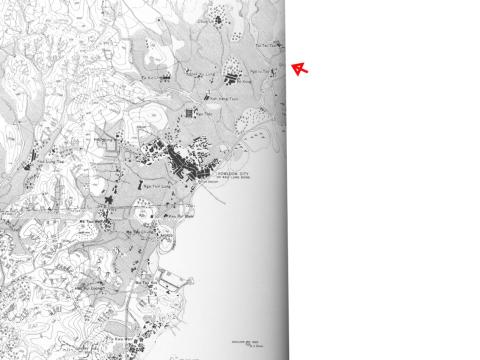
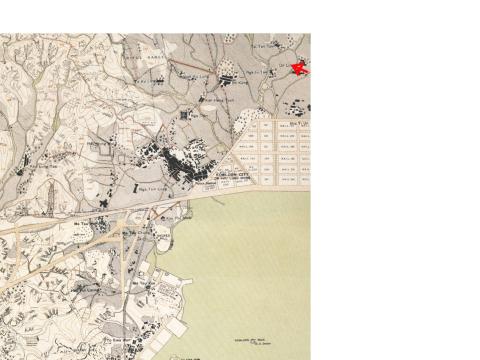
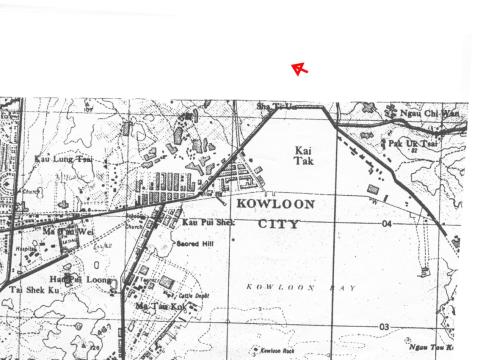
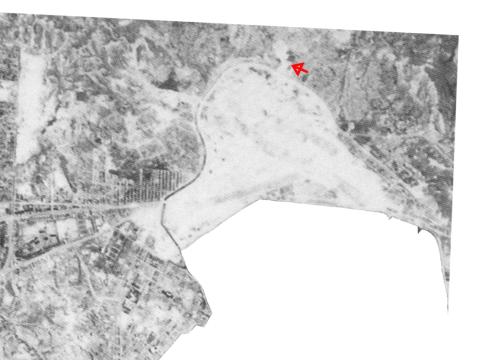
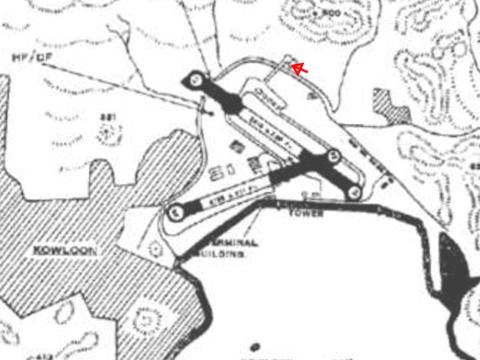
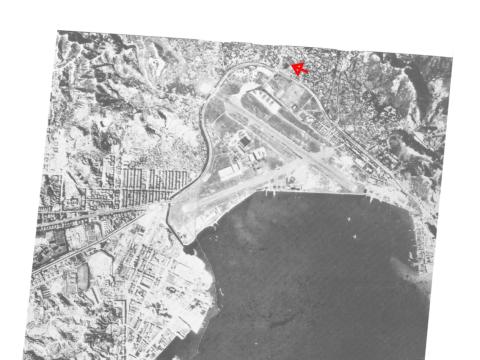
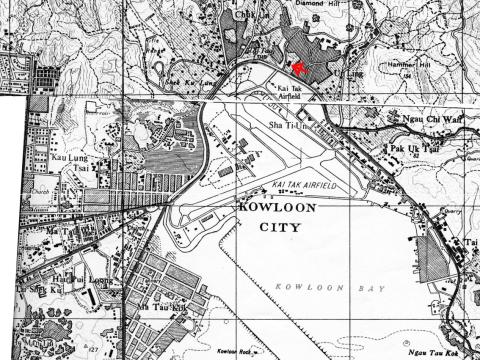


Comments
Kai Tak Airport
Oh yes, those barriers at the top of Run 13! When the bells broke the morning silence my 7 a.m. bus would stop allowing me to watch the airplane taxi across the road in front, make a U-turn and next take off. At other times, my bus would stop when a plane came in to land, or land from the southeast. Yes, no planes took off from the southeast on Runway 31. I can notice the spot being today's Choi Hung Road next to the nullah. Planes were using Runway 13 in 1957-58 when I frequently travelled that area. Around 1958-59, I started to see planes using the new runway built on reclaimed land.
There was a nullah just northwest of where Clear Water Bay Road meets Kwun Tong Road at the foothill. My soccer ball fell into it and I watched it helplessly the next several days while it was rolling in the under-toe of a mini-cascade. They told me I had to get permission from the airport security before I could climb down to retrieve the ball. I didn't pursue it further - I had no long ladder. Wonder if that pigskin is still somewhere under some highrise condos.
Kai Tak Airport
In the early 1950s Runway 13 was extended in a northwest direction across Choi Hung Road and the Kai Tak Nullah to provide a longer take-off run for larger aircraft using the Airport. The extension across the nullah (the U-turn as oldtimer describes)and the beginning of the old runway in San Po Kong are marked by today's Tseuk Luk and Tai Shing Streets.
Kai Tak Airport
Thank Moddsey for pointing out the coordinates of the northwestern tip of Runway 13.
Regarding MrB's comments about the location of the former airport hangar, I might have seen it with small planes inside to my left side after my bus had crossed Runway 13 and swung towards the southeast onto Kwun Tong Road. This would put it on the east side of Kwun Tong Road, northwest of Clear Water Bay Road, and northeast of the RAF Nissen huts which sat on the west side of Kwun Tong Road.
It has been 50 years ago I travelled that way so my memory is a bit cloudy.
Kai Tak airport
I've received some further clarifications:
Civilian / RAF airfields:
Extension of runway 13
Oldtimer, it's a nice thought to think your football might still be there somewhere. We've received photos of the two landmarks Moddsey mentioned, but I guess they look a bit different from how you'd remember them!
Thanks to you both for your comments,
MrB
Extension to Runway 13
The aviation record indicates that the northwestern extension to Runway 13 in San Po Kong was completed in October 1950.
The 1944 USAF aerial reconnaisance photo shows a worn track leading from the Kowloon Hills towards Choi Hung Rd and across the nullah. It is believed that the track was used by British POW labour to transport rubble for the building of the paved runways. The Hedda Morrison 1946 archive photo of Kai Tak taken from Kowloon Peak clearly shows the eroded track and the beginning of the paved runway that was confined within the Airport perimeter road.
Nullah by Kai Tak Airport
Thank you MrB for the reply. I might have misled you. I was thinking of the other nullah, the one right across from the bus stop (see this photo).
This was the same city bus-stop where I spent my time waiting for the Good Hope school bus. Some mornings, us classmates would walk across the road to the east side to play soccer. The nullah there has a east-west orientation and thus ran towards the airport's Nissen huts in this photo; hence security clearance was needed to climb down to the nullah. One day while standing on the east side of the road I had sunny weather above me, but on the west side of the road it was pouring rain for a good half-minute. Another unforgetable moment.
Hedda Morrison photos of Kai Tak, 1946-7
[UPDATE: Giving links directly to the photos doesn't seem to work, so here's the longer way to get to them]
Here are the photos Moddsey refers to. It's worth zooming in on these - the amount of detail is quite something. To see them:
hedda kai tak
Two to note:
This is the photo Moddsey was referring to. The bay at the end of the runway is clearly within the boundary of the road / nullah, so it seems the landing chart I've dated to 1948 was either inaccurate, or it was printed after the extension in 1950. On this photo we can also see the road from the runway to the hangar that started this conversation - but unfortunately the hangar itself is hidden from view by the hill in the foreground.
Oldtimer, you should take a look at this one, as I think it's the same road you've described as your bus route. Also in the bottom left corner of this photo, the fence is broken by what looks to be a pillbox. It's not like any of the pillboxes around Hong Kong island, so I wonder if that was built by the Japanese?
MrB
Kai Tak Airport
Indeed, MrB, the photo you pointed out shows the same road in my bus route. The bottom right corner shows most likely the start of the Clear Water Bay road - that corner mansion with high stonecut-face wall, and the miscellaneous items on the ground on the south side (bottom edge of photo). The open (soccer) field and nullah must be somewhere to the right and behind the tall vegetations.
The buildings inside the airport fence were quite different the way I remember them. It could be because at ground level I couldn't see them past the Nissen RAF huts. If this photo was taken prior to the 1950s, then the Nissen huts were located where these army trucks were parked.
I don't remember seeing the pillbox in this photo. It was likely demolished by the mid-1950s.
Thank you all, for such resourceful materials.
Kai Tak Airport
Hedda's photo of Kwan Tong Road by the airport [titled 'Kai Tak airfield, looking across eastern Kowloon to Lion Rock.', MrB] must have been taken from the hill side to the south of Choi Shek Lane, which now is being flattend. This photo is ringing more and more my memory bell. By 1957, the old pillbox on the foreground has been demolished replaced by a stop used by both the southbound city bus and the Good Hope School bus. This is the very spot I stood many times waiting for one bus or the other. Notice how narrow the start of Clear Water Bay Road was at that time. When they extended Kwan Tong Road, all those dozen boxes were moved to the right (east) side to be with the other metal frames. The reduced storage area remained for quite sometime as a small island. Downbound bus from the hill would circle clockwise around this island to the bus stop on the east side, then used the road by the big mansion (foreground) to travel uphill. Great photo, almost like being there again.
Kai Tak Airport
Hats off to Moddsey for finding these two photos, which he sent along with the following notes:
He also gave some more information about the hangar, which I've posted here.
MrB
Kai Tak in the 1940s and 50s
We've been sent two more photos from those years:
The Japanese enlargement of Kai Tak
Moddsey has sent in a couple of clippings from the Hong Kong News, the english-language newspaper published by the Japanese during the occupation. We're hoping to put a date to the start of the work to enlarge the airfield and lay the paved runways.
The first two are from 26 June and 19 August 1942, and are titled "Kowloon City removals time limit" and "Compensation to Kai Tak residents" respectively. They relate to the clearance of several built-up areas in the 1930 map, to make way for the enlargement of the airfield.
The third clipping is "Work on Kai Tak Airfield - Breaking the sod ceremony", dated 11 September 1942. This indicates that work on the enlargement would begin on September 15, starting with 800 POWs (Prisoners of War) as labourers. By October 1 they say 4,000 workers would be employed at the site, but they don't make it clear if all would be POWs, or there would also be local residents working as labourers.
Though the official start date was September, Tom Forsyth's diary shows that POWs were already working there in June:
So it looks as though the work began somewhere in the period June - September 1942.
It's not clear when the work was finished, but the 'Ernie's story' website notes that the POWs did their best to limit any benefits the Japanese would receive from the POWs' work:
MrB
Re: Japanese Enlargement of Kai Tak
Work on the enlargement of Kai Tak also involved the dismantling of the walls of Kowloon Walled City and using rubble from the Sacred Hill of Sung Wong Toi. To the west of Kai Tak in a park in Ma Tau Wai stands today part of the original boulder inscribed with the Chinese characters of 'Sung Wong Toi' that used to be located on top of Sacred Hill.
The sabotage efforts of the POWs did cause concerns after the Japanese surrender as no one knew the actual strength capability of the runways and where the concrete was likely to fail. The RAF Airfield Constuction Units that arrived in September 1945 spared no time in making Kai Tak operational again and ready to handle larger aircraft e.g. DC-3s.
A 1945-1946 photo archive of Kai Tak of HMS Nabcatcher that shared the aerodrome with the RAF and the civil authorities is available through this link: http://www.royalnavyresearcharchive.org.uk/MONABS/KT_Album.htm
Sung Wong Toi
To add to Moddsey's comments, here are two photos of the original boulder [1, 2], and a Wikipedia article with more information.
POW labour at Kai Tak
There are several POW diaries that mention the work at Kai Tak.
Harry Atkinson:
Thomas Smith Forsyth:
Bernard Castonguay:
Garfield Lowe:
John McGee:
After the Japanese surrendered, there were still POWs working at the airport - but this time the prisoners were the Japanese themselves. The HMS Nabcatcher site mentions them, as well as general conditions around Kai Tak and Hong Kong immediately after the end of the war. Two good examples from that site are the memories of Charles Davidson and E.C. 'Mac' McCarthy.
MrB
Sir Kai Ho Kai
The 'Walk The Talk' site has a good article about Sir Kai Ho Kai, the source of the "Kai" in Kai Tak.
MrB
Books - updated
You may find these books good companion:
The Squadrons Of The Fleet Air Arm 0 85130 223 8
The Squadrons Of The Royal Air Force 0 85130 083 9
Action Stations Overseas 1 85260 319 4
Short Sunderland in World War II 1 85310 429 9
Sunderland Squadrons of World War II 1 84176 024 2
Hawker Hunter in Action 0 89747 273 X
Hawker Hunter in Color 0 89747 181 4
Airport Of The Nine Dragons Kai Tak 0 9586746 0 4
Kai Tak, A History of Aviation in Hong Kong - Government Information Services
The Life And Times Of Sir Kai Ho Kai 962 201 873 4
Enjoy
isdl
Sections of suspected remains of pre-Kai Tak Pier located
Hi there,
You folks might like to take a look at this despite the site is produced in Chinese. It showed photos of a recent dig/survey in last April at Kai Tai. It was in some Chinese newspapers earlier last week. I cannot verify if it's in SCMP or not.
The site also have older reference photos and maps.
Enjoy.
T
http://www.hiking.com.hk/discus/messages/59/51326.html?1211201024
Kowloon City Market Landing Place
The remnants of the pier could be the Kowloon City Market Landing Place. Cultural and historical references to Kowloon City and Kai Tak can be found in this link:
http://www.epd.gov.hk/eia/register/report/eiareport/eia_0592001/12-3.pdf
Kai Tak history
Thanks to Isdl, T, and Moddsey for the links. I've just borrowed a copy of ' The Life And Times Of Sir Kai Ho Kai' from the local library. He was an interesting man, and it's a good read about Hong Kong in the late nineteenth century.
The document Moddsey links to refers to old photos of the area. You can see those photos here.
MrB
More Kai Tak history
A few more odds and ends:
We've been sent this clipping from the SCMP, describing the conditions for POW labour at Kai Tak under the Japanese.
A reader also noted this photo gallery at the Civil Aviation Department website, which has several photos of old the old airport.
Finally here's the section from the book 'The life and times of Sir Kai Ho Kai' (see pg. 31) that describes his involvement with the airport:
MrB
1962 Hawker Hunter crash
I witnessed the 1962 Hunter crash from our roof top at Diamond Hill when I was eleven years old. Using a pair of surplus binoculars I watched the four broke out for landing after passing onto the habour, the last plane did not reappear over the hill, puff of black smoke and later a HKAAF helicopter took off to the crash site. Only very small pisces could be found on the news the next day. Can anyone help me find out more about that crash in any sites?
Also I can remember the black pill box near Tai Hom village Hangar at one time was used by a BBQ merchant as a place for storing his stocks.
We also played soldiers among the surplus RAF vechicles at the junk yard near Clear Water Bay Road.
Thanks,
Steven
re: 1962 Hawker Hunter crash
Does a search through the old newspapers turn up anything? eg a search for 'Hawker' or 'Hunter' in years 1962-63?
RAF or FAA
Broken Wings : Post War Royal Air Force Accidents by James Halley may have the answer if it was an RAF aircraft, 20 or 28 squadron may be. If it was an Fleet Air Arm aircraft then needs other references.
香港全紀錄 (卷二) 一九六零年 - 一九九七年 [Illustrated Chronicle of Hong Kong 1960-1997] by 陳昕 has an entry “military aircraft accident at Kai Tak airport happened on 28 December, 1962” but no further details.
The closest that I can trace is an accident at RAF Kai Tak involving a RAF 45 Sqn EE Canberra in August 1964.
1962 Hawker Hunter Crash
The Hawker Hunter crash that is referred to would appear to be crash of a RAF 28 Squadron FGA Mk 9 (Registration XE535)
on 28 December 1962 on Lion Rock Ridge twelve minutes after taking-off from Kai Tak. You may have to look up the local newspapers to find out more.
1962 RAF Hunter
I was going to try searching the South China Morning Post but I am not sure they keep their archives that long ago and they also require subscription. In Wings over Hong Kong p.141, the exact cause of the accident was never determined. Thanks to everyone again and especially to Moddsey and Mrb for showing the aerial picture of northwestern end of Kai Tak which is the first time in a picture from all the books about Kai Tak that I can almost pick out our house on Main street at Diamond Hill. It brought back so many memories: movie studio, monastery (Chi-Lin temple), crematorium, cemetery (lots of funeral processions), dye factory, soy brewery, streams with little fishes, quarry (not in picture) which gave a continuous supply for the construction of the new runway.
I remembered Centurion tanks guarded by Gurkha soldiers parked just inside the gate at the access road across the Tai Hom hangar just before HRM the Queen's Birthday parade on Nathan road.
Because of the proximity of the RAF, I grew up watching the Vampires, Venoms, Hunters, Canberras, Neptunes and particulary exciting when the huge camouflaged Blackburn Beverly in shiny gloss paint took off!
When the aircraft carrier visited, sometimes they landed all their planes onto Kai Tak for exercises, Buccaneers, Sea Vixens, Gannets etc., what a sight!
I also had pictures on HMS Victorious and USS Coral Sea from my school's Aero club tour but I lost all the pictures when I immigrated to Canada, but thanks to sites like yours I can still reminisce about the past.
re: 1962 RAF Hunter
Typhoon, thanks for the reminiscences - it's always good to hear the stories behind the photos.
You can search through / look at several old newspapers online. See the link above. Unfortunately that doesn't include post-war copies of the SCMP, but one of our anonymous supporters has sent in a couple of relevant clippings and a photo:
Some of Fred Evans' photos show the tanks loaded onto the train, heading to Kowloon for a parade, and then the parade itself.
Kai Tak - old & new runways
I stumbled on this photo. You can see the old runways on the left, complete with the 1950 extension across the road, then on the right the new runway extends out to sea.
Kai Tak's old runway
Aren't those the good old days? People could walk across the runway to their destination. Today, with airport security and restrictions, it is more convenient to say goodbye to friends and relatives at a nearby hotel or coffee shop.
Those tanks for the parade made a lot of dents and scratches on Nathan Road. It took several weeks for the road's surface to recover - I think helped by the passing vehicles.
Post-war Kai Tak
There is a second website that shows photos of HMS Nabcatcher. Some are duplicates of photos on the site moddsey mentioned above, but there look to be some extras too, like this map of the airfield:
http://www.hms-vengeance.co.uk/nabsw.htm
More photos here:
http://www.hms-vengeance.co.uk/monabhk1.htm
Kai Tak in the 1950s
The last minute of the video, starting from 4:22, gives a good long-distance view of the old runways, and then moves in for a close-up of the terminal buildings and runway area:
Kai Tak in the 1950s
Nice long view of 1950s Kai Tak and the old runways from Kowloon Peak. However, the clip of the former Passenger Terminal Building (PTB), Observation Deck and scene of passenger embarkation were added in later. The PTB was opened in November 1962.
Pre-WWII Kai Tak
See my flickr upload about
See my flickr upload about the Longjin Bridge excavation in former Kai Tak Terminal building site.
http://www.flickr.com/photos/27747234@N04/3572841856/
Re: Longjin (Lung Tsun) Bridge & Kowloon City Landing Place
I have enjoyed your 'before and after' shots on Flickr.
Lung Tsun Bridge from the 1890s.
At the land extremity of the stone bridge was the Lung Tsun Pavilion (today's junction of Sa Po Road and Prince Edward Road East) which led to the South Gate entrance to Kowloon Walled City. At the seaward extremity of the bridge was a wooden pier (not in picture) for marine craft to berth alongside. The bridge and the wooden pier were removed for the land reclamation of Kai Tak in 1924 and 1942 respectively.
1964 Kai Tak
For those aviation buffs, a video in German of a Swissair CV-990 (Convair) making an approach to Kai Tak via Cheung Chau Island-Green Island-Stonecutters Island and over Kowloon can be seen here:
http://www.youtube.com/watch?v=6Z0boBiZi94&NR=1
Kai Tak and land reclaimation
I recently read a Chinese book on the history of Kai Tai and I am now interested in the history of the area. Where was the original shoreline of the Kowloon City area when Kowloon and New Territory became parts of the colony? How far was the Kowloon Wall City from the original shoreline? Where the shoreline when the Kai Tak company started land reclaimation to build residential housing? Was the nullah along side the Choi Hung road a natural river or a manmade channel? Is the industrial area in San Po Kong the original site of the first Kai Tak airport? The Japanese military forced POWs to level a hill and use the materials to reclaim more land and expand the airport. Where were that hill and new land reclaimed? The resettlement buildings in Lower Wong Tai Sin Estate were built in the 1950's. What were on that piece of land before the estate was built? Before WWII, there was a stone marker on a hill that was in honour of the last two emperors of Song Dynasty. The marker is called Song Wong Toi, literally the Terrace of the Song Kings. Where was that hill?
Re: Kai Tak and land reclaimation
Hi Lawrence,
Please refer to the 1902 map above. In the centre, there is a triangle that is linked to a square. Both shapes depict walls of the Kowloon Walled City. Immediately south of the walled city there was a densely populated street (Kowloon Street) that led to a pier (Lung Chun Pier 龍津埗頭).
I believe the first site of the Kai Tak Airport is the northeastern part of the 1998 Kai Tak Airport , i.e. around the Concorde Road area. The present-day San Po Kong industrial area became part of the airport during Japanese occupation.
The hill that was levelled by the Japanese was called Sacred Hill (see the 1930 map above). It is where the Sung Wong Toi rock was. The location is just east of the present-day Olympic Avenue.
Which book did you read?
Kai Tak restaurant
I remember hanging out in the restaurant of Kai Tak (before passing through customs and immigration) in the 1990s, but for the life of me can't remember the name. I had wood panneling or another type of brown interior and hadn't been remodeled in decades. Does anyone remember the name and know when it was built? I'm thinking it was either Tin Tin or the Seven Seas Restaurant, but am probably off on both. Thanks!
RE: Kai Tak restaurant
Is this it? : )
http://images3.jetphotos.net/img/1/7/4/9/92118_1046851947.jpg
I think it had a different name in the 1980s, but cannot say for sure.
Re Kai Tak Restaurant
Yes, Tin Tin was one of the Chinese restaurants at Kai Tak Airport.
In the 1990s, it was situated at the eastern end of the Passenger Terminal Building after the buidling's final phase of expansion. The restaurant chain had not served Kai Tak previously.
Kai Tak Restaurant
Thanks for the image! I think the restaurant I was thinking of was "Windows on the World", which is off to the right in the photo.
The Kai Tak runway extension
Looking at this photo, there was a wide 'bridge', where the runway crossed the nullah that runs along Choi Hung Road:
Photo received by email
Date is a guess
Notes from moddsey:
Comments
Kai Tak
Remember it well more especially coming in to land through the mountains over Stinkers corner in a Valleta,no runway out to sea in those day's
Surely someone will remember this experience.
harry
What years were you flying
What years were you flying into Kai Tak harry?
Rgds
J
Kai Tak Airport
Given there are now several major roads in this area, is this road parallel to the runway Kwun Tong Road or Choi Hung Road? or Prince Edward Road which I think did not extend this way until later.
It is refreshing to see how Clear Water Bay Road looked many years ago, and this photo puts me in my school bus as it was travelling uphill. The spacing of the houses on the south side, and their set back from the road, is how I remember them. The walk through Kowloon Dairy (Wai Kee) was serene, free, and playful for this student.
Re: Kai Tak Airport
The ring road entering San Po Kong from bottom right would be today's Choi Hung Road (formerly Clearwater Bay Road)..
Kai Tak Airport
Thanks Moddsey for clearing up my confusion.
Taihom Diamond hill
memon
Kai Tak Airport - Clear Water Bay Road
Greetings. Starting from the top of this photo the first fairly straight line was, still is, Clear Water Bay Road climbing gradually uphill. Next, the dark thick and a bit crooked line was a hedge, and next straight dark line was the nullah which ran under the road to the airport. Whereas the nullah near the runway extension was adjacent to the road, this nullah was a bit remote so not too many outsiders knew of its existance. Today, it must be running below some streets to the sea. Regards, Peter
Then looking at Google's satellite view, it looks as though the 'bridge' is still there, where Tai Shing Street crosses the nullah.
[gmap markers=small red::22.337110405752387,114.19498237968583 |align=Center |zoom=18 |center=22.337110984649904,114.19508099555969 |width=450px |height=350px |control=Small |type=Satellite]
Re: Kai Tak Runway Extension
Yes, the bridge is still there and Tai Shing Street was the location of the old main runway: http://gwulo.com/node/1832
1962 HAWKER CRASH
Steven , just stumbled on your message - from some years ago now .
But the crash you saw was a Hawker Hunter piloted by my wife's uncle David. It was a very sad story as he left a young son Drew.
The Pilots sister Anne is well and now lives in Australia . His brother Bill my wifes father sadly died af years ago.
I'm interested if you receive this message to hear if you can recall anything else and what you are now doing .
1962 HAWKER CRASH
Two images of microfilmed newsprint relating to the pilot's activities in December 1962 have been added to the "Photos" section
Kai Tak / MONAB - 1945
Message from Bob:
Pre 1941 Kai Tak Photos
This website provides two excellent overhead photos of Kai Tak Aerodrome from pre-1941.
See here for the view of the civilian hangar, slipway and pontoon and here
for the view of the Kai Tak Reclamation (Bund), Kowloon City Police Station (at bottom), the civilian hangar (at centre), RAF hangar, slipway and buildings (far distance) and Sai Kung Road traversing Kowloon City.
Old RAF HQ
The Old RAF HQ Buildings in Choi Hung are now occupied by the Academy of Visual Arts, shown, rather confusingly on Centamap, under their old title "The HK Police Detective Training School".
The entrance at the top of a rather imposing granite staircase, is topped by the AVA's logo, but if you visit, look closely under their logo and there in bas-relief, is the RAF Crest complete with "Per Ardua ad Astra".
Officials at the AVA would prefer you write/phone them before going there but if you arrive without norice and plead "Father/Grandfather served here etc etc" you can usually be allowed to take a look round!
I would have liked to input a picture but I'm afraid I couldn't cope with the instructions! Is there not a simpler method of uploading pictures?
re: Old RAF HQ
Hi, that sounds like the Officers' Mess Building. We've got a few photos of it at: http://gwulo.com/node/7612, but any more you can add will be welcome. For starters just do these four steps:
And the photo will be uploaded for all to see.
Regards, David